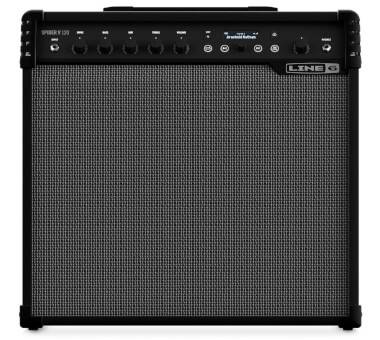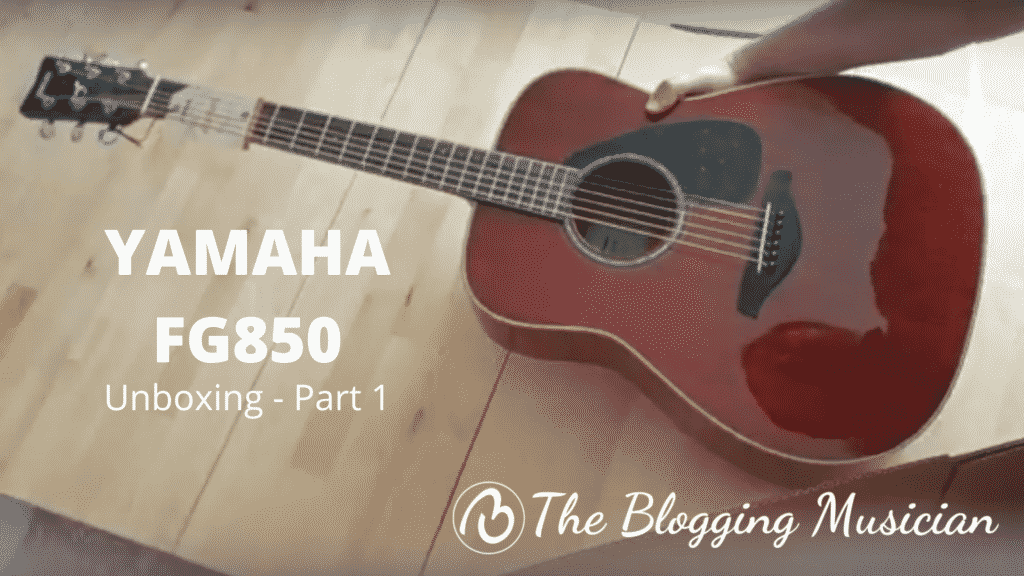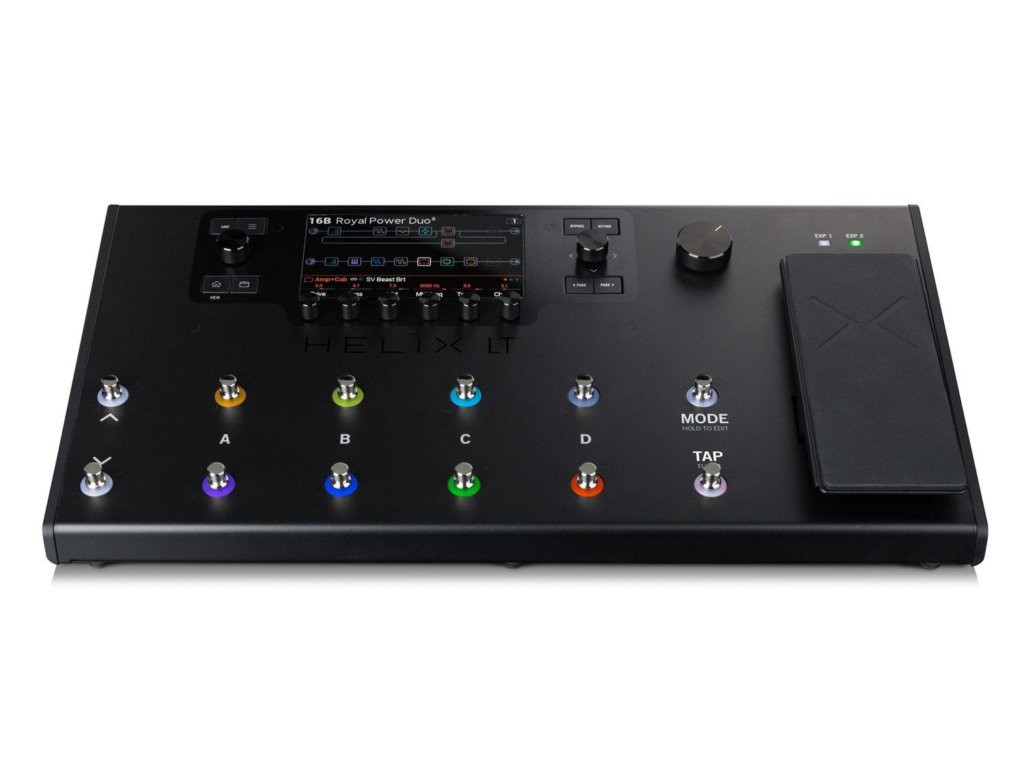
Line 6 has been making Spider amps for years. With each model, an upgrade or two is added. In some cases, the upgrades seem small; from the Spider III to the IV on the 15W models there’s almost no difference except for a few aesthetic changes and an FBV pedal port. As you move up to the larger models, things look a little more in-depth. The Spider IV 75 features a large library of presets and custom user presets/banks. The latest in the “crawly” tech series of amps by Line 6 is the Spider V. Today, I’ll be comparing the Spider IV to the Spider V.
I have the Spider IV 75, and the V 120 amps. At first glance, the Spider IV 75 has a lot more knobs and buttons. On the surface, a novice might think, “There’s not much difference between the IV and the V.” However, the differences are large.
Line 6 took a great leap from the IV to the V models and they did so by learning from the successes of the Firehawk series of effects and amps. One of the oldest features brought back into the amplifier line are the jam tracks. Line 6 has provided Spider V owners with a variety of high quality tracks to jam along with. This first showed up in the Line 6 Spider Jam series of amps back in 2008; And if you look back a little further, some other companies were making “practice amps” that did that, too. Some would say that Line 6 had the higher quality tracks. I can say that the new Spider V tracks sounds very good. Remember, the purpose of these tracks is to practice not to record your greatest hits. They serve their purpose well and the sound quality is backed up by the dual-amp powered split speaker system that Line 6 has provided with the Spider V amps. This separation of amplification is a first for the Spider series, and there is a big difference in tone between the IV and the V based on that alone.
The Spider IV came out in 2009, only one year after the Spider Jam. Come 2015 we saw the birth of the Firehawk series, and the beast: The Helix. The following year, Spider V was born. I’ve always said that the best things companies can do from model to model is learn from previous models. That’s exactly what Line 6 has done with Spider V. They learned from the Jam and included great tracks in the Spider V. They learned from the Firehawk’s iOS app-based “mission control” and included a similar app for the Spider V.
Roger, Mission Control.
When you open up the app, it’s very clear that the Spider V’s fewer buttons (when compared to the Spider IV) does NOT mean it has fewer features. You’ve opened the app and right from the home screen there is no doubting the power of the amplifier. Amps, cabinets, overdrive/dynamics, mod effects, synth effects, reverbs, delays, and more. The visual aspect alone is fantastic. You not only see your options, but their icons are very much modeled after their real-life counterparts. For instance, if you’re amongst the many who love the ol’ classic MXR compressor you’ll easily find a red compressor pedal in the dynamics category. I especially appreciate these visual aids in the amplifier category. There’s something great about really seeing the model amps visually. You picture the original in your head and remember what they sound like. The amp models not only resemble the originals, but they are presented in relative size differences so you know if you’re selecting a small combo amp or a large twin-speaker monster amp.
Customizing the signal chain and the FBV 3 Floorboard.
Customization on the FBV 3 via Spider V is a process that is not entirely clearly explained in the manual; It is son the Firehawk, though. Customizing the signal chain is easy, just drag and drop things in the order you prefer. Much like the Firehawk, only some effects blocks can be moved, and those moveable ones have select placement options. For those who are still learning about effects chains, this is a significant limitation; You’ll always have good results. For instance, if you place your delay before the amp or after the amp the effect is MUCH different. Still, you’ll not run into anything awkward like naively putting the delay before the noise gate or initial compressor. Line 6 has made a powerful effects system with a very user-friendly interface that fits the needs of novice and experienced users alike. However, unlike the Firehawk, there doesn’t seem to be a way to customize which button the floor controller will control which effect in the chain. At first, it looks like they are just randomly distributed which is not ideal for most users. We like things the way we want things! Don’t fret, I contacted Line 6 myself and cleared this mystery up.
How to customize the FBV 3 Pro Floorboard via Spider V:
First sort out your effects, settings, and locations in the chain. Save the FBV for last. Once your patch is entirely setup, glance at the floorboard and check if the lights are in the locations you’d like them. For example, if you want the mod effects in the FS2 slot but they are in the FS4 slot then we need to change that. Here’s how! The board automatically sorts things out… but only at first. On the app, drag and drop the mod effect (in this example) out of position and back again into the original position. You’ll see it change on the floorboard, too. So yes, with just a little nudge you can force the change from the app to the board. Easy peasy and no time lost!
Ports.
The Spider V has the usual ports we’ve seen in the past: Input, headphones, MP3 input. Additionally, they provided an excellent XLR stereo output on the Spider V 120 (and models above) for recording, output to powered speakers, and direct to PA. What I love about this feature is that it doesn’t rely on the amp’s master volume control. Some people don’t like this because they are used to the way most effects processors work; You have to adjust the master volume before playing with the faders in post-sound. With Spider V, the master volume affects the amp’s volume while the PA (or mixer) takes the patch’s preset volume (alone) through the XLR outputs. So you can use your amp as a monitor on stage without overwhelming the PA system. This also simplifies things in the mix so you don’t run into bad tone – great idea, Line 6! As others have learned, not balancing out your levels can result in tone overdrive and an overheated, sizzling thin sound. ¡No bueno! Line 6 also learned something from the Firehawk: A direct line is better than Bluetooth. The Spider V has USB ports on the back for both computer and mobile. Mac, PC, Android, and iOS are all available for use with the Spider V via a rear port. No app disconnects (as seen with Bluetooth on occasion) and you can charge your mobile device while working.
(Note: Powerhouses like the iPad Pro won’t charge from this port, they require more juice. You can charge your phone, however!)
Hidden automation.
You may have discovered this on your own, but for those who are new to the Spider V there’s more to it than what you see on the surface. Spider V’s lack of knobs are simplified by the Amp/FX buttons. You can change whether these knobs control the amp’s settings (drive, volume, and EQ) or if they control the effects in the change (dynamics, mod, delays, reverb, etc.) But wait, there’s more. Turning the knob up obviously increases the effect, but which parameter? Is the delay time, mix, feedback, etc. going up? Are they going up together or just one assigned parameter? These are the questions that boggle the mind with a single knob. The answer is simple if you keep the app opened while turning a single knob. You’ll notice that it’s almost magical! Turning the knob up will cause some parameters to go up, but others will go down! For instance, you’re using an overdrive pedal with a drive knob, gain knob, and tone knob. Perhaps something like the Rat Pedal is in your chain – 3 knobs, 3 parameters, all controlled by ONE knob on the amp. Why? Because you’d never hike up the gain and drive together up to 10! That would sound like death. Or would it? Well, you can easily set everything to 10 on the app, but for those who know it wouldn’t sound great Line 6 has provided simple automation. You turn the amp’s knob up and the simulated Rat Pedal will adjust gain up and drive down accordingly to balance out the overall tone. This up/down automation happens throughout the amp’s effects.
I have to say, since I’m a less-is-more kinda guy I do like the effects automation and the FBV 3 setup. This gives me quick access to great tone without spending a lot of time setting things up. Delivery is fast, and clean without a complex interface on the floor or on the amp.


